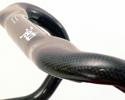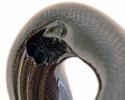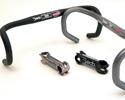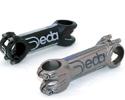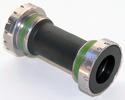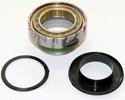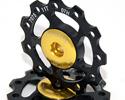
Recently on Cyclingnews.com |
Quick Spins – November 21, 2007Edited by James Huang Got Tech? Send press releases, news, and tech questions to the Cyclingnews tech-heads. Welcome to Quick Spins, an all new section within Cyclingnews' tech coverage were we put some of the smaller items that land on the tech desk to the test.
Italian firm Deda Elementi knows a thing or two about sculpting carbon fibre into weird and wonderful shapes, and has more than ample experience in the pro ranks as it has been supplying its venerable Newton bar to the pro peloton for donkey's years, along with a smattering of integrated one-piece bar and stem offerings and various clip-on aerobar designs for those of the time trial persuasion. Deda takes a distinct departure from the traditional and makes good use of its capabilities with the new Electa carbon road handlebar. Concerns over the suitability of carbon fibre as a handlebar material (at least from a safety point of view) are gradually giving way to appreciation of its vibration damping properties, overall stiffness and the possibilities for non-conventional, ergonomic shapes which make the bar a more comfortable resting place. Granted, there's still the unhappy scenario of your carbon bars snapping rather than bending in a crash, and some riders still swear against their use for multi-stage races. The logic behind this is that, if need be, you could likely finish a stage on a set of bent aluminium handlebars, but not on shredded carbon ones. Nevertheless, with its flattened upper area to provide extra resting room for weary hands, the Electa occupies that happy medium between a one-piece carbon fibre bar/stem combination and the bog standard two-piece design. What's more, Deda says that because the Electa's round centre section extends a good distance outwards from the stem clamping point (it's about 6cm long on either side), fitting a set of clip-on aerobars is still possible, too. The Electa is only available with a relatively deep 140mm anatomic bend, but unlike some other carbon bars we've tested, Deda doesn't skimp on material and extends the final horizontal section back far enough to make them feel plenty safe enough to lean your weight onto without the worry of slipping off the end. The Electa is offered in 42, 44 and 46cm widths, measured outside-outside, as well as two color schemes: there's the white lettered version (pictured) and a slightly racier red flame option. Brake and shift housings are internally routed on the bar's underside for a clean look, and the twin-tube design will accommodate Shimano, SRAM, or Campagnolo setups. Moreover, this also allows users to omit using handlebar tape up top if you are so inclined without worrying about cable flopping in the breeze, although we found the bare carbon finish somewhat slippery when wet ('shock to the heart… and you're to blame…'). Thankfully, once out on the road, the Electa backs up its seductive Italian styling with an awesome ability to kill road buzz whilst also feeling impressively stiff to boot. Even wrenching on the bars with all the upper body strength of a...umm, road cyclist, doesn't produce any tell tale signs of unwanted flex. Larger hands may find the anatomic drops a little tight in the mid section, but otherwise the bar's varied cross section provides multiple hand configurations to reduce pressure points on longer rides. And so that brings us to the inevitable discussion about price. What else might you buy for US$375? Well, for a start you could have three of Deda's perfectly acceptable Newton handlebars, with a few bucks to spare. Having also spent time on the Newton recently, could we really justify spending more than three times as much for something just 28g lighter? The honest answer: no. But in that hypothetical world where money is no object: we'd take the Electa every time. /BA Weight: 230g (44cm outside-outside) PhotographyFor a thumbnail gallery of these images, click here Images by James Huang/Cyclingnews.com
Deda Elementi Zero100 Servizio Corse stem - all alloy, all the time
With carbon fibre finding its way into virtually every nook and cranny of modern bicycle design, it's refreshing to see Deda still has some faith in good old aluminium alloy when it comes to stem design with its newest Zero100 Servizio Corse. Deda's premium offering utilises thin-walled 3D-forged aluminium construction and 6-4 titanium alloy fixing bolts to keep weight down to an absolute minimum. Actual weight of our 120mm test model is a very reasonable 142g, putting it about 12g lighter than Deda's own full carbon Forza stem. We tested the Zero100 in combo with both the Electa and Newton handlebars, and suffice to say it kept front end stiffness on par with a British upper lip after the recent Rugby World Cup final. When you also consider that, at US$150, the Zero100 is also roughly half as expensive as the Forza while seemingly sacrificing nothing in terms of function, the phrase 'value for money' takes on a whole new meaning. While we're on the subject of saving moolah, it is also worth mentioning that Deda also offers the Zero100 in a standard, non-Servizio Corse model, which shares an identical aluminum forging but exchanges the six titanium bolts for stainless steel ones. Naturally, this adds a few grams, but also lops the price in half yet again. Now that's value for money... Alright, we'd better stop obsessing about price and weight, or we'd soon be advising you that a stem fashioned from a bamboo stick would do the job just as well. In any case, seven sizes are available for the Zero100 (80-140mm in 10mm increments), albeit in only one stem angle of 82°. There's also the option of a standard black finish or Deda's rather suave 'dark metal polish' (pictured) - the Newton handlebar comes in both these finishes, too. What more can one really ask of a stem's performance? Top marks - almost. /BA Weight: 142g (120mm version) PhotographyFor a thumbnail gallery of these images, click here Images by James Huang/Cyclingnews.com
VCRC Bike ceramic bottom bracket - easy spinning for less coin
Ceramic bearings are still a red-hot topic, and for good reason as excess bearing friction needlessly saps what little power most of us put into the pedals. Now that hybrid ceramics have been around for a little while, though, lower-cost options have begun to crop up that offer the same or similar (at least that's the pitch) improvements in performance while still leaving a bit of scratch for a reasonable dinner. One such offering is the hybrid ceramic external-type bottom bracket from VCRC, a direct-sales outfit that also offers a wide range of other hybrid ceramic bearing components and upgrades. At first glance, there isn't really much to discuss here as it's a virtual carbon copy to a standard Shimano offering in terms of both appearance and weight. A quick turn of the cranks, however, reveals a far smoother spin that, at least subjectively, strikes us as impressively similar to far more expensive models. Some of the reduction in friction, though, is likely due to the omission of one of the usually-included lip seals (the one underneath the plastic 'top hat'). When compared to a similarly set up Shimano unit, though, the VCRC model is still markedly speedier. Unfortunately, we weren't able to produce any objective data in regards to power savings, nor does the VCRC brand name confer the air of long-term durability of some of its competition. However, our tester presented no issues whatsoever during its tenure (which included stints on a cyclocross machine and even a winter commuter) so that at least provides one vote of confidence on our end. Regardless, we are more than comfortable in saying that it's a noticeable improvement over stock, and at just US$179.95, it's an experiment that carries only a modest cost but can potentially deliver substantial returns. Weight: 101g PhotographyFor a thumbnail gallery of these images, click here Images by James Huang/Cyclingnews.com
|


